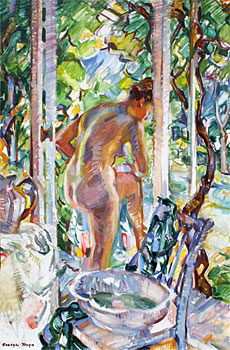Evelyn Page 'Nude in a Doorway' Tue, 23 Sep 2008

"Over seven decades as an instinctive representational painter, she [Evelyn Page] has developed her palette as much as she has the human interest of her subject matter. Her treatment of colour has given her a place as one of New Zealand's foremost colourists. As a painter she has maintained a unique faith with the formative years of her training, grounded as it was in the traditions of the British School. But like other progressive artists she has not remained rigid in her ideas and has developed an interest in others work, particularly the modern masters. Cézanne, Bonnard, Kokoschka, Augustus John and Matthew Smith have all drawn her interest more than her New Zealand contemporaries. Yet she has never followed them slavishly but carefully assimilated what has suited her independent purpose."
Neil Roberts: Towards Independence, catalogue essay, Evelyn Page - Seven Decades, Robert McDougall Art Gallery, 1987 (page 57)
In 1970 the outstanding achievements of Evelyn Page were recognised and celebrated with a major retrospective exhibition of 98 works at the National Art Gallery in Wellington. Douglas Lilburn, a close friend of the artist, wrote a brief introduction to the exhibition catalogue in which he paid particular tribute to Page's perpetual appetite for innovation and creative development. Lilburn drew attitudinal parallels between Page and the Japanese printmaker, Hokusai, who he quoted saying: "by the age of 80, I shall have made further progress, and by the age of 90, I shall see into the mystery of things". This proved to be prophetic as Evelyn Page, who was 71 at the time, continued to experiment and extend the boundaries of her painting practice for another 17 years.
Nude in a Doorway, painted in the artist's 74th year, was Evelyn Page's last major nude, before the onset of arthritis curtailed her ability to work in a large scale, and remains as a glowing testimony to her sustained creative energy and enthusiasm to innovate. At the age of 66, Page set off for Salzburg to attend Oscar Kokoschka's 'School of Seeing' and although quite conspicuously older than the majority of much younger students, persisted with the unfamiliar prerequisite methods of working and soon won the admiration of many around her. "What I learned at Salzburg" Page recalled, "was to let the subject impress as simply as possible." Works painted after she returned to New Zealand in 1968 and throughout the 1970s demonstrate a reduced essentialising of detail and increasingly broad yet highly painterly treatment of backgrounds. This enabled the form of the main subject, particularly in the case of a figure, to be presented without distraction as the primary subject of the work.

Nude in a Doorway demonstrates her concerns with the essence of form as she began experimenting with the stylized 'pattern-making' of compositional elements developed by Matisse during his Nice period. Like the modern French master who inspired her, Page created this exotic fantasy by assembling favourite pieces of fabric, foliage and familiar objects.… the ewer, the punchbowl the striped tablecloth and the antique chair appear in most of her larger paintings of nudes. These objects are assembled into an intoxicating blend of pattern and colour that would both compliment and intensify the luscious flesh tones of a favourite model. In this case the model was Kate Farquahar, the daughter of the late Radiya and Professor David Farquahar, professional associates and close friends of Evelyn and her husband Frederick.
Once again the subject poses against familiar glowing foliage of the ornamental grape and lime tree dappled by sunlight at the Page's garden at Waikanae.
For many years her friend and gallery owner, Elva Bett had tried to persuade Page to exhibit her work and in 1974 she held the second of only two exhibitions of her career (the first being at the John Leech gallery in Auckland in 1972). The major work of this show was Nude in a Doorway, along with some new still lifes and several watercolour nudes.
Her close friends, Dr Diana Mason and husband Bruce Mason, took the opportunity to add this fine example of her practice to their already extensive art collection. In 1980 she painted Bruce Mason, accompanied by several preparatory drawings.
From the Diana & Bruce Mason Estate:
Bruce Edward George Mason (September 28, 1921 - December 31, 1982) was a New Zealand playwright, actor, critic, and fiction writer. Mason is best known for his classic New Zealand plays 'The End of the Golden Weather' 1991 and' The Pohutukawa Tree'. He was a co-founder of Wellington and New Zealand's first professional theatre Downstage Theatre in 1964, and wrote a weekly column Music on the Air for the NZ Listener from 1964 to 1969. He met his wife Diana while studying at Victoria University College in 1939. A noted obstetrician specialising in women's health, she shared his interest in the arts. They had three children, Belinda, Julian and Rebecca. Bruce Mason died in 1982. Diana Mason died in June 2007, nearly 25 years after her husband. The Bruce Mason Centre in Takapuna, Auckland is named after him. It was opened in 1996 and contains a 1164 seat auditorium.
